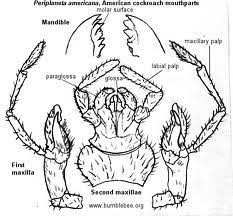W.B.C.S. Examination Notes On – Mouth Parts Of Periplaneta – Zoology Notes.
The kinematics of the biting and chewing mouthparts of insects is a complex interaction of various components forming multiple jointed chains.Continue Reading W.B.C.S. Examination Notes On – Mouth Parts Of Periplaneta – Zoology Notes.
The non-invasive technique of in vivo cineradiography by means of synchrotron radiation was employed to elucidate the motion cycles of the mouthparts in the cockroach Periplaneta americana. Digital X-ray footage sequences were used in order to calculate pre-defined angles and distances, each representing characteristic aspects of the movement pattern. We were able to analyze the interactions of the mouthpart components and to generate a functional model of maxillary movement by integrating kinematic results, morphological dissections and fluorescence microscopy.
During the opening and closing cycles, which take about 450–500 ms on average, we found strong correlations between the measured maxillary and mandibular angles, indicating a strong neural coordination of these movements. This is manifested by strong antiphasic courses of the maxillae and the mandibles, antiphasic patterns of the rotation of the cardo about its basic articulation at the head and by the deflection between the cardo and stipes.
In the functional model of the maxilla, its movement pattern is explained by the antagonistic activity of four adductor-promotor muscles and two abductor-remotor muscles. However, beyond the observed intersegmental and bilateral stereotypy, certain amounts of variation across subsequent cycles within a sequence were observed with respect to the degree of correlation between the various mouthparts, the maximum, minimum and time course of the angular movements. Although generally correlated with the movement pattern of the mandibles and the maxillary cardo-stipes complex, such plastic behaviour was especially observed in the maxillary palpi and the labium.
- Labrum or the upper lip is a broad and roughly rectangular shaped structure. It hangs from the front edge of the head on the lower side. Hypo pharynx is a tongue like structure in the floor of the mouth.
- Mandibles are a pair of hard, strong, large, dark colored structures found one on either side with jagged inner edges. They move in horizontal motion and crush the food present in-between them.
- Maxillae are a pair of structures which lie outside and behind the mandibles. Each consists of three parts known as protopodite, exopodite and endopodite.
- Labium is said to be formed by the fusion of the second pair of maxillae. It forms the broad median lower lip and has a pair of 3-segmented labial palps on either side which is sensory in nature.
Please subscribe here to get all future updates on this post/page/category/website


 Toll Free 1800 572 9282
Toll Free 1800 572 9282  mailus@wbcsmadeeasy.in
mailus@wbcsmadeeasy.in



















































































































